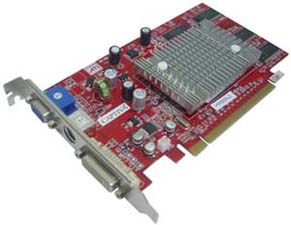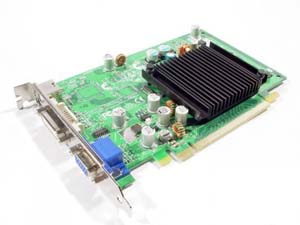

Radeon X300 HyperMemory and Gforce 6200 with TurboCache.
sure many have heard of graphics cards with TurboCache (in the case of NVidia) or HyperMemory (for ATI), but what are these two new technologies?
We will try to explain as clearly as possible.
A graphics card for high performance optener, you need (and a good processor) a good amount of memory, and this is as fast as possible.
This in high-end graphics is no problem, but if we have a chart to give us a high performance 3D and DirectX 9c (and especially that meets the Shader Model 3.0) and also that it is a graphic cheap, the thing becomes more complicated.
For this reason, taking advantage of the bandwidth offered by PCIe 16x (4 GB in both directions, compared to 2.1GB total AGP port), both manufacturers have developed similar technology, known as we have said, TurboCache in the case of NVidia and HyperMemory in the case of ATI. Basically this tegnologias
cards can offer good performance and sufficient memory at an affordable price. So where's the catch?. Well mainly is to create a graph in which only a portion of memory is built into the graphics card, used to supply the rest (until the specified amount of memory) the computer's RAM, a lot cheaper than incorporating the Card Cell. This memory is used dynamically, ie used as needed, being released when the graph is not used, unlike what happens with the integrated graphics of memory, using the RAM to stock up on all the memory they need, but reserving this memory from the beginning to the chart.
To give us a better idea, and for instance, a card Nvidia 6200 TurboCache 256MB only has 64MB memory card, using the RAM for a total of up to 256MB (192MB), but only when needed, so that RAM is available for other uses if the graph is not being used.
Ultimately, the performance of the cards with this technology is similar to the card with the same processor in which the total graphics memory is on the card, but (and there's always a but) if and when we have a fast enough machine and a significant amount of memory (obviously mount these cards if you have only 512MB of RAM is not a good idea), but at a fairly tight. The bandwidth of memory (Memory Banding) is also quite high on these cards.
Let's see some data last a couple of models of cards using this technology. The data given in this order:
Name - Speed \u200b\u200bCore / memos (MHz) - Men IINC / Nominal - Bus - PixelL Shader - Pixel Pipelines - Mmemos Banding (GB / s)
Ati RADEON X 300SE 128MB (HM) - 325/300 - 32/128 - 64 bits - 2.0 + - 4 - 12.8
Ati Radeon X 300 SE 256MB (HM) - 325/300 - 128/256 - 64 bits - 2.0 + - 4 - 12.8
NVidia GeForce 6200 16-128MB (TC) - 350/350 - 16/128 - 32 bits - 3.0 - 4 - 10.8
NVidia GeForce 6200 32-128MB (TC) - 350 / 350 - 32/128 - 64 bits - 3.0 - 4 - 13.6
NVidia GeForce 6200 64-256MB (TC) - 350/275 - 64/256 - 64 bits - 3.0 - 4 - 12.4

0 comments:
Post a Comment